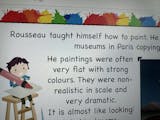#TheCompleteSeries5lessons
This Just So Stories planning pack will introduce your class to the much-loved short stories of Rudyard Kipling, and the best part is that is all planned and ready for you to deliver to your class! The pack has everything you need for a great Year 4 reading comprehension week - detailed plans, engaging slideshows, and differentiated worksheets and activity ideas.
#Lesson1HowtheWhalegothisThroat
In the first lesson in this Year 4 English planning pack, your Year 4 class will read ‘How the whale got his throat’ together, after being introduced to Rudyard Kipling and why he wrote his famous Just So Stories.
Your class can then demonstrate their understanding of ‘How the whale got his throat’ by answering a range of comprehension questions. In the alternative activity, children will be challenged to explore and update some of the language used within the text.
This lesson contains an easy-to-follow lesson plan, a teaching input slideshow with the full text of the story included, differentiated activity ideas and a range of printable resources to support your class as they carry out their independent learning activities.
What's included:
- Slides
- How the Whale Got His Throat' Story Sheets
- Glossary Sheet
- Worksheet 1A/1B/1C
- Word Detectives Sheet
#Lesson2HowtheCamelgothisHump
As a class, you will first read 'How the camel got his hump' together – the second of the Just So Stories by Rudyard Kipling.
This Year 4 reading comprehension lesson focuses on developing your children's skills of inference and deduction. After reading and discussing the main events of 'How the camel got his hump', children are asked to demonstrate their understanding of the different characters' thoughts, feelings and motives in a range of discussion and role-play activities.
Included within this KS2 English lesson pack is a detailed plan, an engaging set of slides, and differentiated worksheets and resources. The full text of the story is included both on the slides and worksheets.
What's included:
- Slides
- How the Camel Got His Hump' Story Sheets
- Worksheet 2A
- Discussion Cards
- Talk Show Help Sheet
- Talk Show Name Tags
- Challenge Card
#Lesson3HowtheRhinocerosgothisSkin
In this Just So Stories KS2 English lesson pack, children read the third tale from the collection together; 'How the Rhinoceros Got His Skin'.
This Year 4 reading comprehension lesson encourages your class to discuss the characters, setting, actions and reactions within 'How the Rhinoceros got his skin', before they progress to their independent activities, where they are challenged to ask, answer and discuss specific comprehension questions in pairs or small groups.
This easy-to-download lesson pack includes the full text of the story, along with a comprehensive lesson plan, a detailed set of slides and differentiated worksheets and activities to suit children of all abilities.
What's included:
- Slides
- How the Rhinoceros Got His Skin' Story Sheets
- Roll and Answer Sheets A/B/C
- Octahedral Dice Template
- Agree or Disagree? Cards
#Lesson4HowtheElephantgothisTrunkPart1
Children will read together the first part of Rudyard Kipling's 'How the Elephant Got His Trunk'.
They will then discuss and answer a variety of comprehension questions as a class, before being challenged to demonstrate their powers of prediction for what they think will happen in the second part of 'How the elephant got his trunk'. Children are encouraged to base their ideas on what has already happened in the story (as well as their knowledge of other Just So Stories by Rudyard Kipling), either as a written piece, or in a role-play situation.
Download this Year 4 reading comprehension lesson pack, which includes everything you need: an easy-to-follow plan, informative, engaging slides and differentiated resources.
What's included:
- Slides
- How the Elephant Got His Trunk' (Part 1) Story Sheets
- Prediction Sheet 4A/4B/4C
- Challenge Cards
- Animal Faces
#Lesson5HowtheElephantgothisTrunkPart2
In this final lesson in this Year 4 English planning pack, children will first revisit their predictions from the previous lesson as to what might happen in part 2 of 'How the Elephant Got His Trunk'.
As a class, children then read and discuss the rest of the story, and are challenged to either: write a summary of the whole tale, or write a simpler version of 'How the elephant got his trunk' which is aimed at a younger audience.
This year 4 reading comprehension lesson pack is 'ready-to-teach': it contains a detailed plan, a slideshow for the teacher input, and a range of printable resources to cater to all abilities during your class's independent work.
What's included:
- Slides
- How the Elephant Got His Trunk' (Part 1) Story Sheets
- How the Elephant Got His Trunk' (Part 2) Story Sheets
- Worksheet 5A/5B/5C
- Summary Cards
- Challenge Card
- Booklet Template
Free Overview (Medium-Term Plan)
Download a free overview to support your teaching of this scheme of work.
Free Assessment Grid
Download a free, editable assessment grid to support your teaching of this scheme of work.
Curriculum Objectives covered
Reading - Comprehension Objectives:
- listening to and discussing a wide range of fiction, poetry, plays, non-fiction and reference books or textbooks
- reading books that are structured in different ways and reading for a range of purposes
- using dictionaries to check the meaning of words that they have read
- discussing words and phrases that capture the reader’s interest and imagination
- checking that the text makes sense to them, discussing their understanding and explaining the meaning of words in context
- asking questions to improve their understanding of a text
- drawing inferences such as inferring characters’ feelings, thoughts and motives from their actions, and justifying inferences with evidence
- predicting what might happen from details stated and implied
- identifying main ideas drawn from more than one paragraph and summarising these
- participate in discussion about both books that are read to them and those they can read for themselves, taking turns and listening to what others say




























































